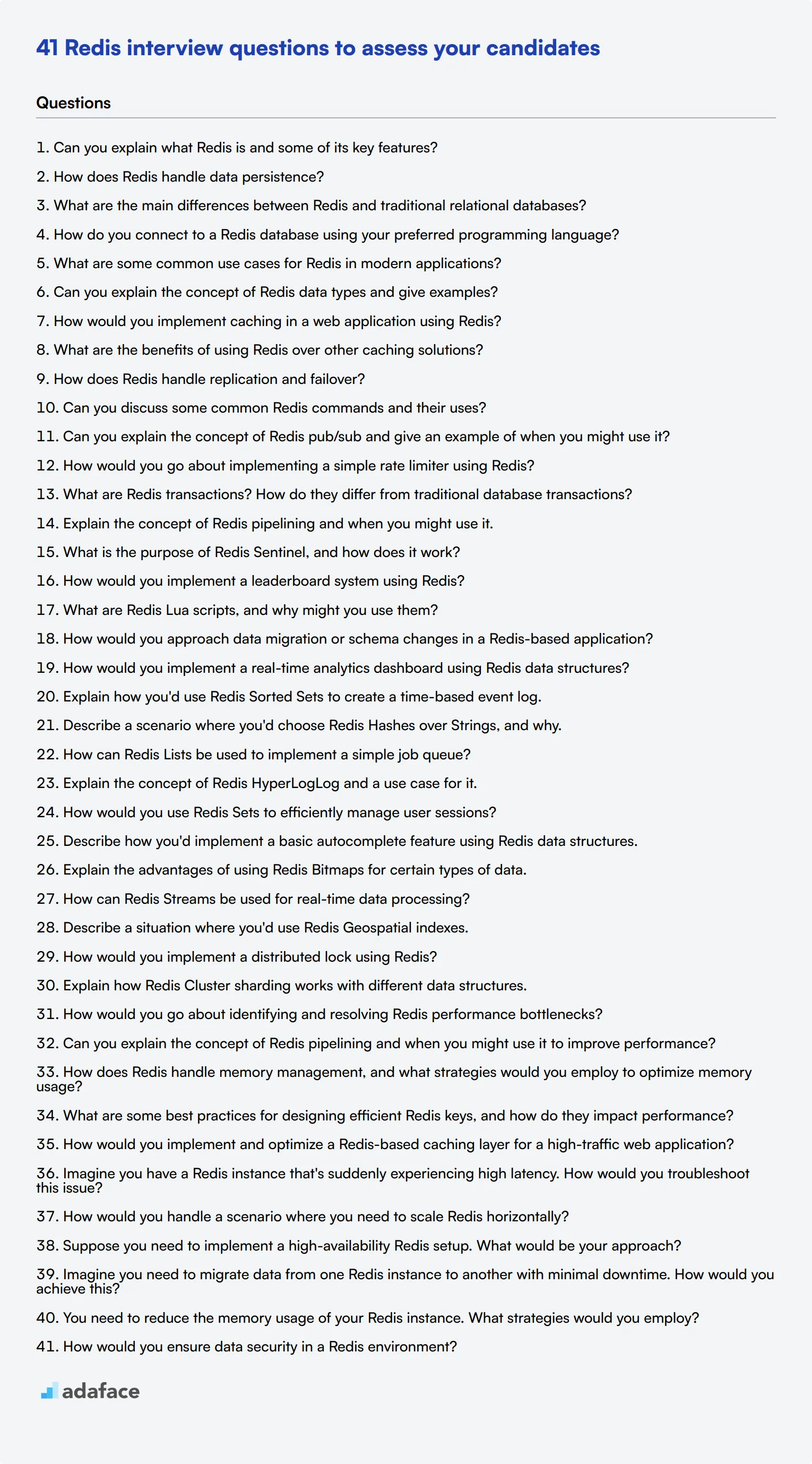Redis, an open-source, in-memory data structure store, has become a popular choice for caching, real-time analytics, and more in modern software architectures. As a recruiter or hiring manager, it's crucial to assess candidates' Redis knowledge thoroughly to ensure you're bringing the right talent on board.
This blog post offers a comprehensive set of Redis interview questions, covering basics, junior developer topics, data structures, performance optimization, and situational scenarios. By using these questions, you'll be able to evaluate candidates' Redis expertise across various skill levels and use cases.
Incorporating these questions into your interview process will help you identify top Redis talent efficiently. For a more thorough evaluation, consider using a backend engineer assessment test before the interview to streamline your hiring process.
Table of contents
10 basic Redis interview questions and answers to assess candidates
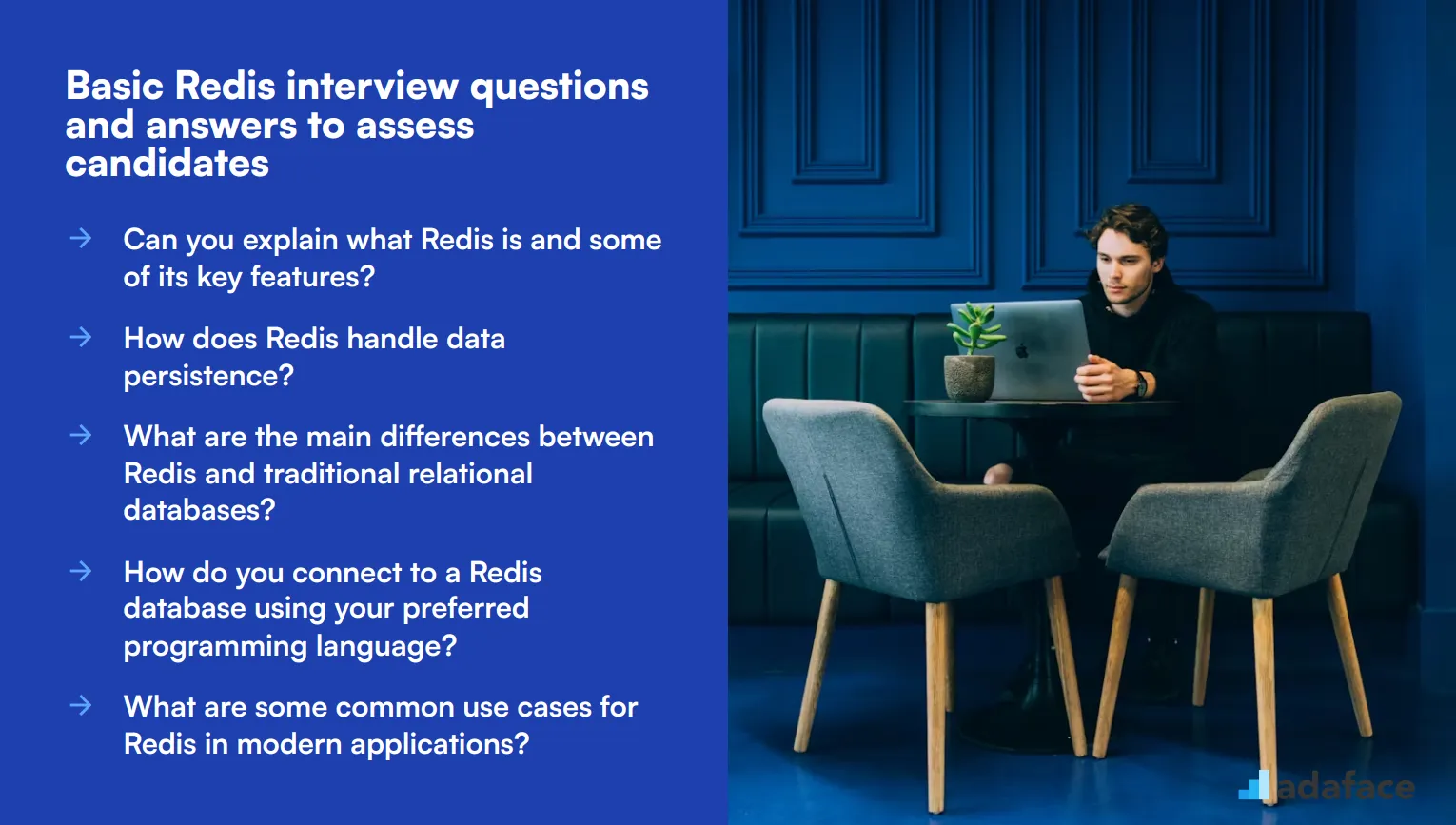
To assess whether your candidates have the fundamental knowledge of Redis necessary for your team, use these basic interview questions. They will help you gauge the technical proficiency and problem-solving skills of applicants, ensuring they are well-equipped to handle the challenges of NoSQL development.
- Can you explain what Redis is and some of its key features?
- How does Redis handle data persistence?
- What are the main differences between Redis and traditional relational databases?
- How do you connect to a Redis database using your preferred programming language?
- What are some common use cases for Redis in modern applications?
- Can you explain the concept of Redis data types and give examples?
- How would you implement caching in a web application using Redis?
- What are the benefits of using Redis over other caching solutions?
- How does Redis handle replication and failover?
- Can you discuss some common Redis commands and their uses?
8 Redis interview questions and answers to evaluate junior developers
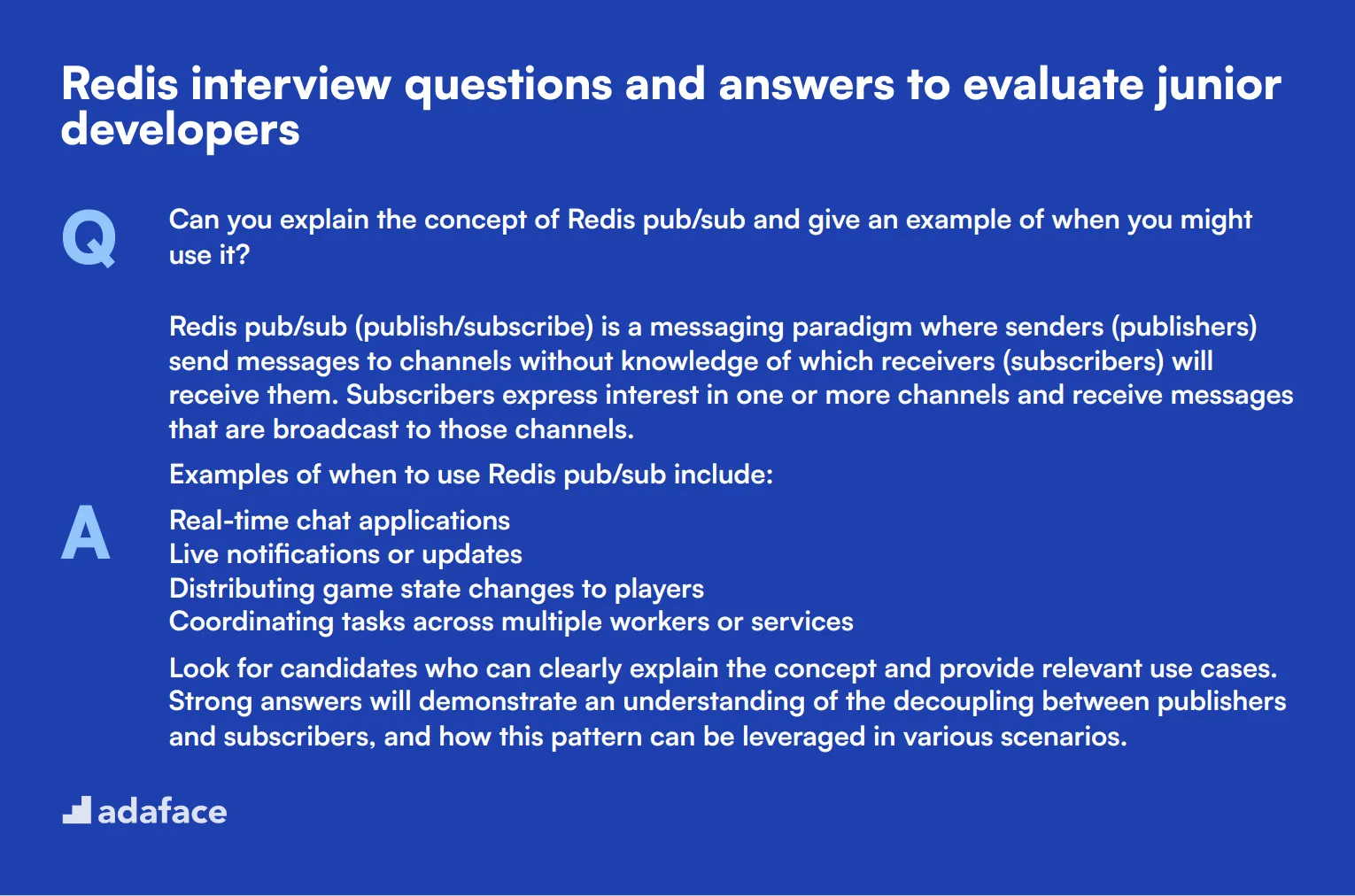
Ready to put your junior Redis developers through their paces? These 8 interview questions are designed to help you assess their foundational knowledge and problem-solving skills. While they won't require candidates to write code on the spot, these questions will give you valuable insights into their understanding of Redis concepts and practical applications. Remember, the goal is to evaluate their potential, not to stump them!
1. Can you explain the concept of Redis pub/sub and give an example of when you might use it?
Redis pub/sub (publish/subscribe) is a messaging paradigm where senders (publishers) send messages to channels without knowledge of which receivers (subscribers) will receive them. Subscribers express interest in one or more channels and receive messages that are broadcast to those channels.
Examples of when to use Redis pub/sub include:
- Real-time chat applications
- Live notifications or updates
- Distributing game state changes to players
- Coordinating tasks across multiple workers or services
Look for candidates who can clearly explain the concept and provide relevant use cases. Strong answers will demonstrate an understanding of the decoupling between publishers and subscribers, and how this pattern can be leveraged in various scenarios.
2. How would you go about implementing a simple rate limiter using Redis?
A simple rate limiter using Redis could be implemented using the following approach:
- Use a Redis key to represent each user or IP address
- Set the key's value to the number of requests made
- Use the INCR command to increment the counter for each request
- Set an expiration time on the key using EXPIRE
- Check the counter value before allowing each request
This implementation allows you to limit the number of requests within a specific time window. For example, you could limit users to 100 requests per hour.
Strong candidates should be able to outline this basic approach and discuss potential improvements or variations. Look for understanding of Redis commands like INCR and EXPIRE, and awareness of distributed systems challenges in implementing rate limiting.
3. What are Redis transactions? How do they differ from traditional database transactions?
Redis transactions allow the execution of a group of commands in a single step. They are different from traditional database transactions in several ways:
- Redis transactions are atomic, meaning all commands in a transaction are executed sequentially, and other clients' requests won't be served in the middle of a transaction.
- Unlike traditional databases, Redis doesn't provide rollback functionality. If a command fails, other commands in the transaction will still be executed.
- Redis transactions don't support check-and-set (CAS) operations by default, although this can be achieved using the WATCH command.
A good answer should highlight these differences and explain that Redis transactions are primarily used for ensuring that a group of commands is executed without interruption from other clients, rather than for ensuring data consistency across multiple operations.
Look for candidates who understand the trade-offs between Redis's approach and traditional ACID transactions, and can discuss scenarios where Redis transactions are beneficial or limiting.
4. Explain the concept of Redis pipelining and when you might use it.
Redis pipelining is a technique used to improve performance by sending multiple commands to the server without waiting for the replies, and then reading the replies in a single step. This reduces the number of network round trips between the client and server, significantly improving throughput, especially over high-latency connections.
Pipelining is useful in scenarios such as:
- Bulk data insertion or updates
- Retrieving multiple pieces of data in a single operation
- Implementing custom atomic operations that require multiple commands
Look for candidates who can explain the performance benefits of pipelining and provide examples of its practical applications. Strong answers might also touch on the limitations of pipelining, such as increased memory usage on the server and the need for client-side buffering of commands and responses.
5. What is the purpose of Redis Sentinel, and how does it work?
Redis Sentinel is a distributed system designed to manage Redis instances, providing high availability through automatic failover. Its main purposes are:
- Monitoring: It constantly checks if master and replica instances are working as expected.
- Notification: It can notify system administrators or other programs about issues in the Redis deployment.
- Automatic failover: If a master is not working, Sentinel can start a failover process where a replica is promoted to master.
Sentinel works by running as a separate process from Redis instances. Multiple Sentinel processes are deployed to avoid single points of failure. They communicate with each other to reach consensus about the state of the Redis deployment and to coordinate failover actions.
Strong candidates should be able to explain the role of Sentinel in ensuring high availability and discuss how it fits into a Redis deployment architecture. Look for understanding of concepts like quorum, leader election, and the trade-offs involved in configuring Sentinel for different reliability requirements.
6. How would you implement a leaderboard system using Redis?
A leaderboard system in Redis can be efficiently implemented using sorted sets. Here's a basic approach:
- Use a sorted set to store user scores, with the score as the sorting criteria.
- Use the ZADD command to add or update user scores.
- Use ZREVRANGE to get the top N users.
- Use ZRANK or ZREVRANK to get a user's position in the leaderboard.
- Use ZSCORE to get a specific user's score.
This implementation allows for efficient updates and retrievals, with operations typically running in O(log(N)) time complexity.
Look for candidates who can outline this approach and discuss potential optimizations or variations. Strong answers might include considerations for handling ties, implementing separate leaderboards for different time periods (daily, weekly, all-time), or strategies for dealing with very large leaderboards.
7. What are Redis Lua scripts, and why might you use them?
Redis Lua scripts are a way to execute custom logic on the Redis server using the Lua programming language. They offer several advantages:
- Atomicity: Scripts are executed as a single operation, ensuring that no other Redis commands are executed in between.
- Reduced network overhead: Complex operations that would require multiple round-trips between client and server can be executed in a single call.
- Reusability: Scripts can be stored on the server and called by name, allowing for code reuse across different clients or applications.
Common use cases for Lua scripts include:
- Implementing custom atomic operations that aren't natively supported by Redis
- Optimizing complex workflows by reducing client-server communication
- Creating reusable business logic that needs to operate on Redis data
Look for candidates who can explain the benefits of Lua scripts and provide examples of when they might be useful. Strong answers might also touch on potential drawbacks, such as increased server load or the need for careful script management in a production environment.
8. How would you approach data migration or schema changes in a Redis-based application?
Data migration or schema changes in Redis require careful planning due to its schemaless nature. A general approach might include:
- Design the new data structure or schema
- Write a migration script to transform existing data
- Test the migration process thoroughly in a staging environment
- Choose a migration strategy (e.g., offline, online with double-writing, or gradual)
- Execute the migration, potentially using Lua scripts for atomicity
- Update application code to work with the new structure
- Verify data integrity post-migration
Candidates should discuss considerations such as:
- Minimizing downtime during migration
- Ensuring data consistency throughout the process
- Handling rollback scenarios
- Managing memory usage during migration
Look for answers that demonstrate understanding of Redis's flexibility and the challenges of database migrations in a production environment. Strong candidates might also mention tools or techniques specific to Redis, such as using RDB snapshots or AOF for backup before migration.
12 Redis questions related to data structures
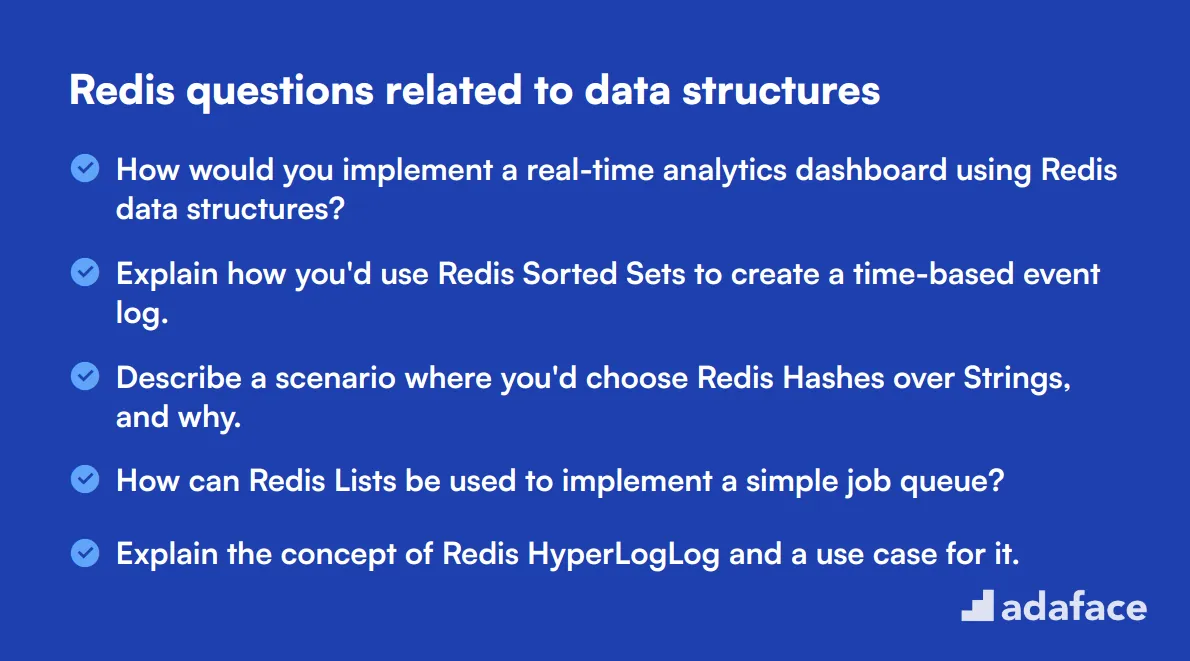
To assess candidates' understanding of Redis data structures, use these questions to probe their practical knowledge. These inquiries are designed to reveal a NoSQL developer's proficiency in leveraging Redis' unique features for efficient data management and problem-solving.
- How would you implement a real-time analytics dashboard using Redis data structures?
- Explain how you'd use Redis Sorted Sets to create a time-based event log.
- Describe a scenario where you'd choose Redis Hashes over Strings, and why.
- How can Redis Lists be used to implement a simple job queue?
- Explain the concept of Redis HyperLogLog and a use case for it.
- How would you use Redis Sets to efficiently manage user sessions?
- Describe how you'd implement a basic autocomplete feature using Redis data structures.
- Explain the advantages of using Redis Bitmaps for certain types of data.
- How can Redis Streams be used for real-time data processing?
- Describe a situation where you'd use Redis Geospatial indexes.
- How would you implement a distributed lock using Redis?
- Explain how Redis Cluster sharding works with different data structures.
5 Redis interview questions and answers related to performance optimization
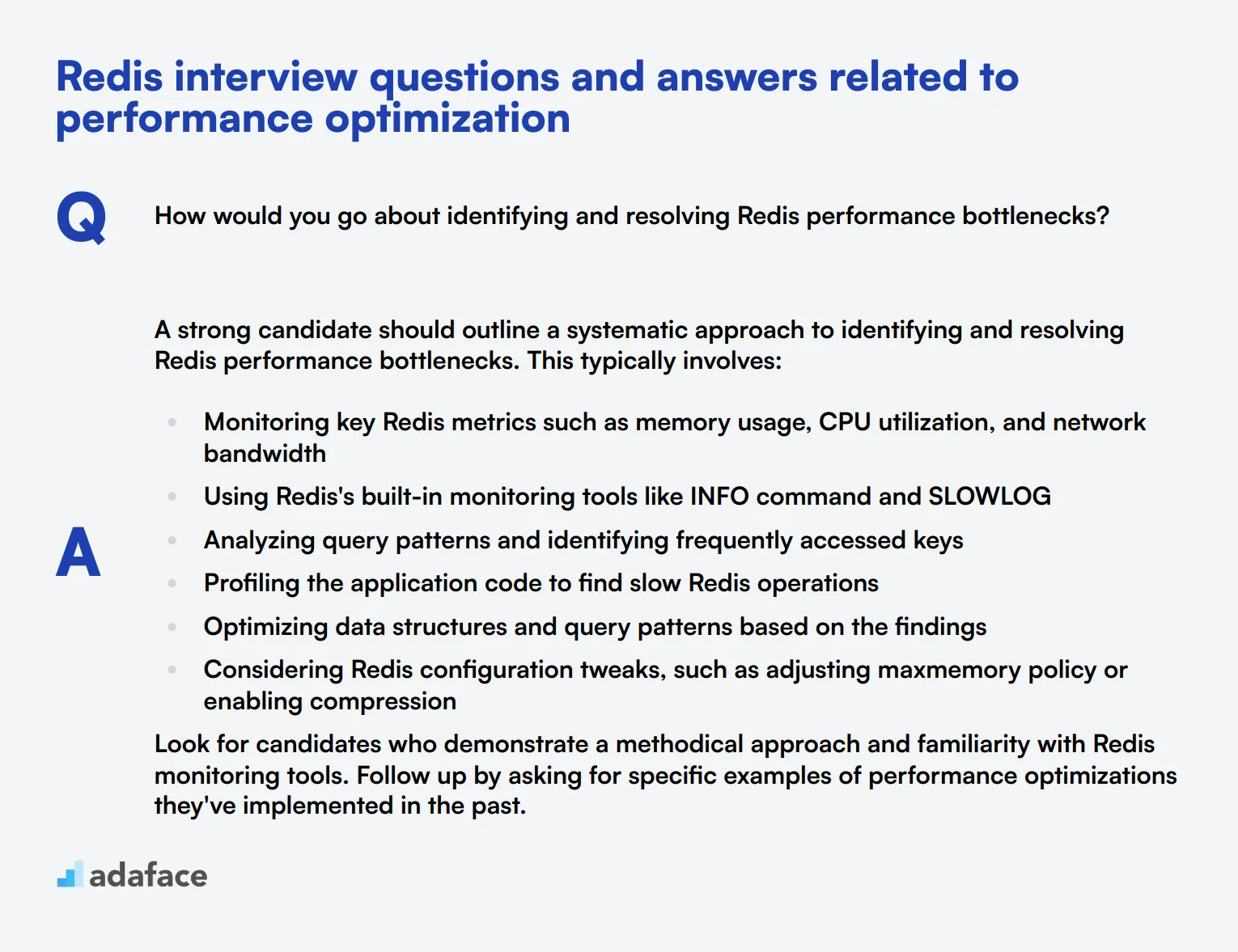
Ready to turbocharge your Redis interviews? This list of performance optimization questions will help you separate the Redis rookies from the Redis rockstars. Use these questions to gauge a candidate's understanding of Redis performance tuning and their ability to optimize Redis-based applications. Remember, the goal is to find someone who can make Redis purr like a well-oiled machine!
1. How would you go about identifying and resolving Redis performance bottlenecks?
A strong candidate should outline a systematic approach to identifying and resolving Redis performance bottlenecks. This typically involves:
- Monitoring key Redis metrics such as memory usage, CPU utilization, and network bandwidth
- Using Redis's built-in monitoring tools like INFO command and SLOWLOG
- Analyzing query patterns and identifying frequently accessed keys
- Profiling the application code to find slow Redis operations
- Optimizing data structures and query patterns based on the findings
- Considering Redis configuration tweaks, such as adjusting maxmemory policy or enabling compression
Look for candidates who demonstrate a methodical approach and familiarity with Redis monitoring tools. Follow up by asking for specific examples of performance optimizations they've implemented in the past.
2. Can you explain the concept of Redis pipelining and when you might use it to improve performance?
Redis pipelining is a technique used to improve performance by sending multiple commands to the server in a single request, without waiting for the individual responses. This reduces network round trips and can significantly improve throughput, especially in high-latency scenarios.
Candidates should mention that pipelining is particularly useful when:
- Executing a large number of independent commands
- Working with high-latency networks
- Performing bulk operations like mass inserts or updates
- Implementing data modeling patterns that require multiple operations
Look for answers that demonstrate an understanding of the trade-offs involved in pipelining, such as increased memory usage on the server and client sides. Ask follow-up questions about how they would implement pipelining in a real-world scenario.
3. How does Redis handle memory management, and what strategies would you employ to optimize memory usage?
Redis is an in-memory data store, so efficient memory management is crucial for optimal performance. Candidates should be able to explain that Redis uses a combination of techniques to manage memory, including:
- Configurable maxmemory setting to limit Redis's memory usage
- Various eviction policies (e.g., LRU, LFU) to remove keys when memory limit is reached
- Data compression for certain data types
- Memory fragmentation management
For optimizing memory usage, look for strategies such as:
- Choosing appropriate data structures (e.g., using Hashes instead of individual keys for structured data)
- Implementing key expiration policies
- Using Redis's object encoding optimizations
- Monitoring and managing memory fragmentation
- Considering data compression techniques
A strong candidate will also mention the importance of regular monitoring and tuning based on application-specific usage patterns.
4. What are some best practices for designing efficient Redis keys, and how do they impact performance?
Efficient key design is crucial for Redis performance. Candidates should discuss the following best practices:
- Use short, descriptive key names to reduce memory usage
- Implement a consistent naming convention (e.g., using colons as separators)
- Avoid using very long keys, as they increase memory usage and network overhead
- Consider using namespaces to organize keys and prevent conflicts
- Use key expiration (TTL) when appropriate to automatically manage data lifecycle
Regarding performance impact, look for explanations on how efficient key design:
- Reduces memory usage, allowing more keys to be stored in RAM
- Improves network performance by reducing data transfer
- Enhances the effectiveness of Redis's internal data structures and algorithms
- Facilitates easier key management and reduces the likelihood of key collisions
Ask follow-up questions about specific scenarios where the candidate has implemented these practices and the resulting performance improvements they observed.
5. How would you implement and optimize a Redis-based caching layer for a high-traffic web application?
Implementing a Redis-based caching layer for a high-traffic web application requires careful consideration of caching strategies and performance optimizations. A strong answer should include:
- Identifying frequently accessed data suitable for caching
- Implementing an appropriate caching strategy (e.g., read-through, write-through, or write-behind)
- Using efficient data structures and serialization methods
- Setting appropriate TTLs for cached items to balance freshness and performance
- Implementing cache invalidation mechanisms to ensure data consistency
- Using Redis data types like Sorted Sets for leaderboards or Lists for queues
For optimization, look for mentions of:
- Implementing batch operations and pipelining to reduce network overhead
- Using Redis Cluster for horizontal scalability
- Monitoring and tuning Redis configuration for optimal performance
- Implementing fallback mechanisms in case of cache misses or failures
- Considering Redis Enterprise features for advanced use cases
Evaluate the candidate's understanding of caching principles and their ability to apply Redis-specific optimizations to real-world scenarios.
6 situational Redis interview questions with answers for hiring top developers
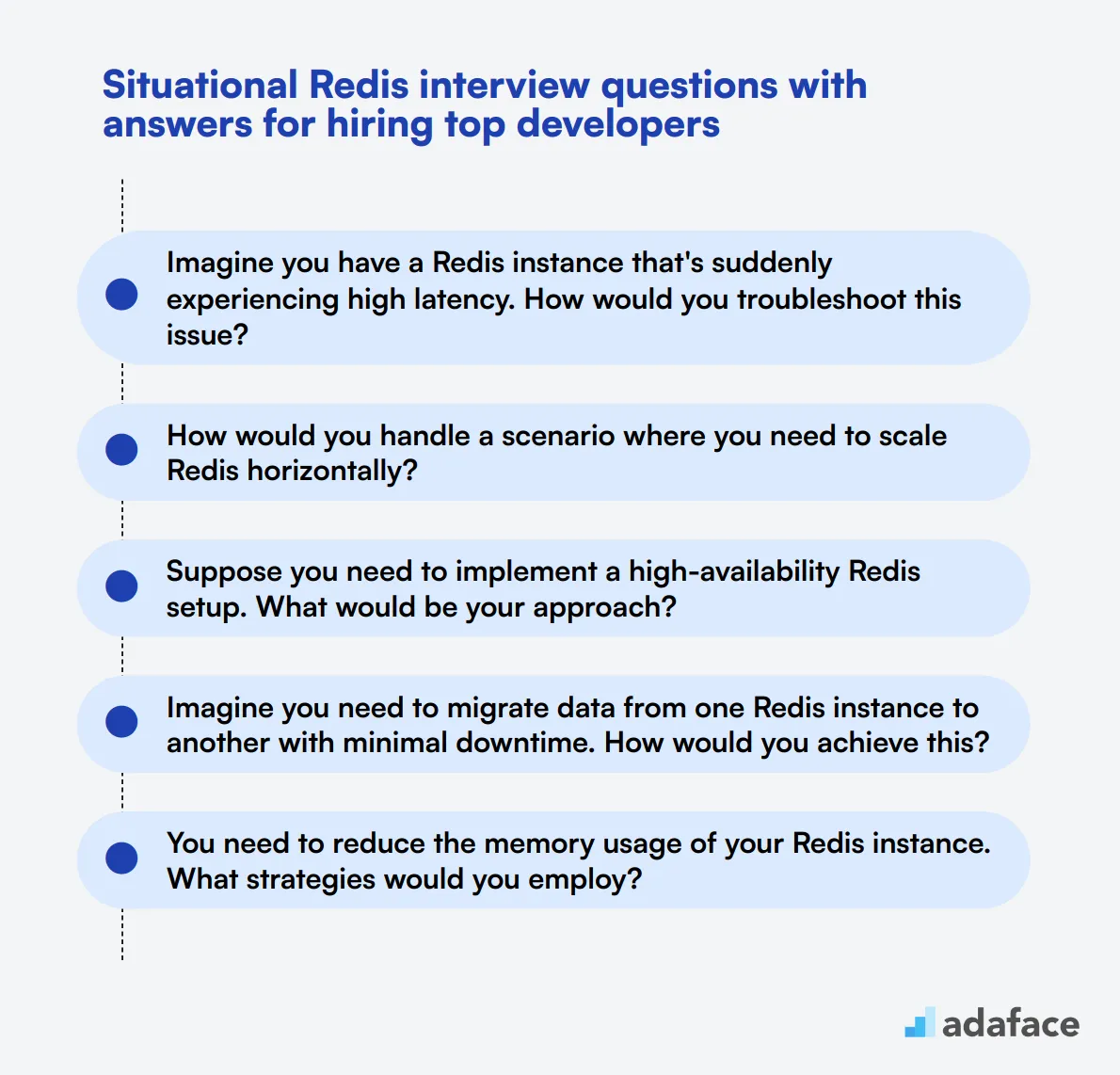
To gauge how well candidates can handle real-world scenarios with Redis, ask them these situational questions. They reveal problem-solving skills and practical knowledge crucial for top-tier developers.
1. Imagine you have a Redis instance that's suddenly experiencing high latency. How would you troubleshoot this issue?
First, I'd monitor the Redis server metrics, such as memory usage, CPU load, and command execution time. Tools like Redis Monitor or external monitoring systems like Prometheus can be very useful.
Next, I would identify if the problem is related to a specific command or pattern of commands. Using the Redis Slow Log to check for slow queries can provide insights.
Finally, I'd check for network issues, including latency in the communication between the client and server. Adjusting configurations, optimizing commands, or scaling the system might be necessary.
Look for a candidate who mentions specific monitoring tools and techniques. They should demonstrate a methodical approach to identifying and resolving bottlenecks.
2. How would you handle a scenario where you need to scale Redis horizontally?
To scale Redis horizontally, I would use Redis Cluster, which allows data to be automatically partitioned across multiple Redis nodes.
Setting up Redis Cluster involves configuring multiple nodes and ensuring data is distributed evenly. It's crucial to monitor the cluster and handle failover scenarios efficiently.
An ideal candidate should discuss the setup process, including configuration, data distribution, and failover handling. They should also mention the importance of monitoring and maintaining the cluster.
3. Suppose you need to implement a high-availability Redis setup. What would be your approach?
For high availability, I would use Redis Sentinel, which provides automatic failover and monitoring capabilities.
I would set up multiple Redis instances and configure Redis Sentinel to monitor them. In case the master node fails, Sentinel will promote one of the replicas to master, ensuring minimal downtime.
Listen for details about configuring Redis Sentinel and the importance of having multiple instances. The candidate should emphasize monitoring and quick recovery to maintain high availability.
4. Imagine you need to migrate data from one Redis instance to another with minimal downtime. How would you achieve this?
I would use Redis replication to keep the new instance updated with the current data. First, set up the new instance as a replica of the old one.
Once the data is fully synchronized, I'd switch the roles, making the new instance the master and the old one a replica. This approach minimizes downtime and ensures data consistency.
The candidate should explain the replication process clearly and emphasize the importance of minimizing downtime. Look for their understanding of data synchronization and role switching.
5. You need to reduce the memory usage of your Redis instance. What strategies would you employ?
First, I would analyze the current memory usage patterns using the Redis INFO command and identify the largest consumers of memory.
Then, I would consider data eviction policies, Redis data types optimization, and possibly compressing data. Using efficient data structures like hashes instead of strings can also save memory.
Look for a candidate who mentions analyzing memory usage and provides multiple strategies for optimization. They should demonstrate a good understanding of data eviction policies and data structure optimization.
6. How would you ensure data security in a Redis environment?
To ensure data security, I would start by enabling authentication and using strong passwords. Configuring Redis to listen on private network interfaces only and using firewalls to limit access is crucial.
Additionally, I would use encryption for data in transit by setting up SSL/TLS. Regularly updating Redis to the latest version and monitoring for security vulnerabilities is also important.
The ideal candidate should talk about multiple layers of security, including authentication, network security, and data encryption. They should also emphasize the importance of regular updates and monitoring.
Which Redis skills should you evaluate during the interview phase?
In any hiring process, it is important to remember that a single interview cannot encompass every aspect of a candidate's capabilities. For Redis, however, there are a few core skills that are critical to assess, as they directly impact how effectively a candidate can utilize this powerful in-memory data structure store.
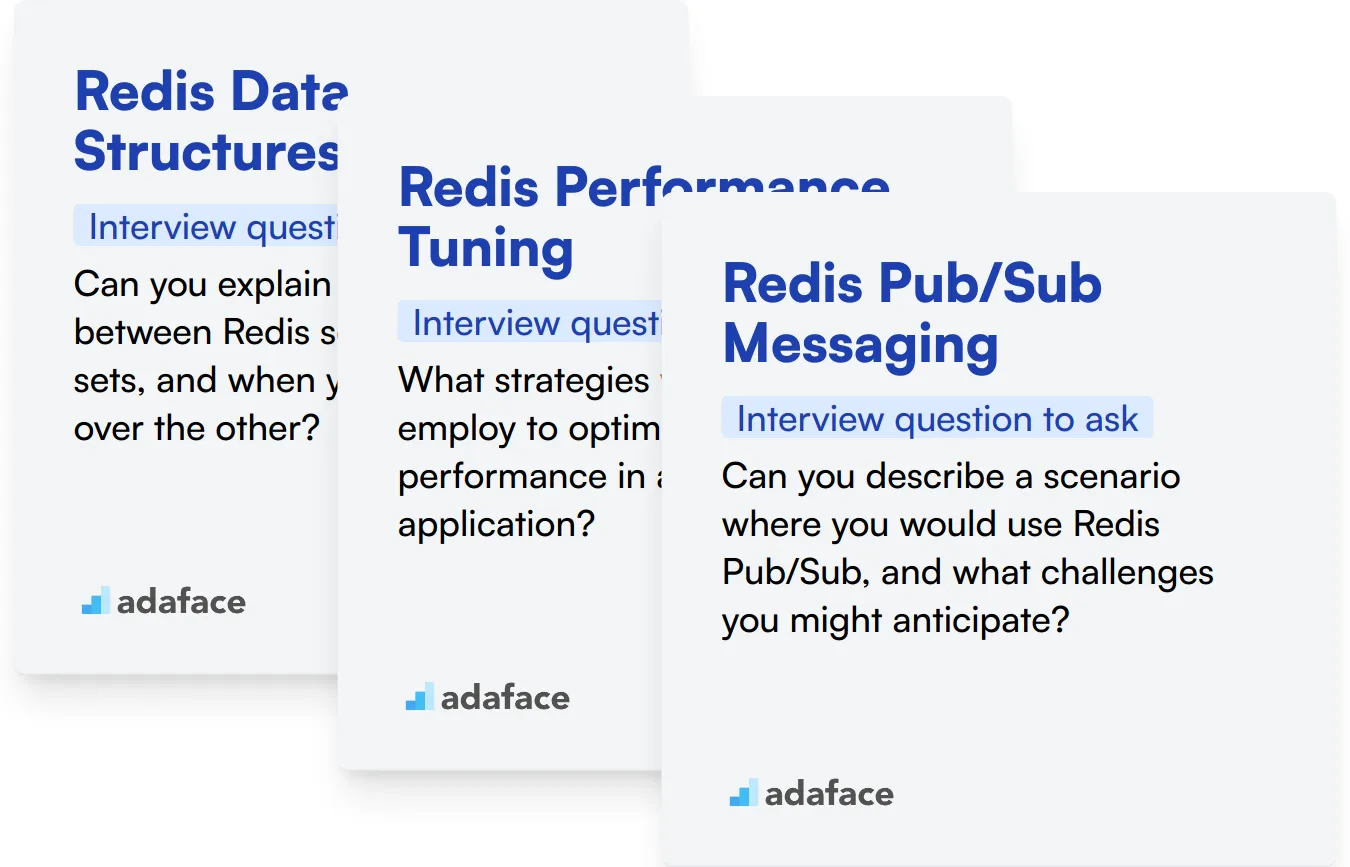
Redis Data Structures
To evaluate this skill, consider using an assessment test that includes multiple-choice questions specifically focused on Redis data structures. You can explore options from our library like the Data Structures test to filter candidates effectively.
Additionally, you can ask targeted interview questions to further gauge a candidate's expertise in Redis data structures. For instance:
Can you explain the differences between Redis sets and sorted sets, and when you would use one over the other?
When evaluating their response, listen for clarity in their explanation and the ability to provide practical scenarios. A good candidate should also mention the O(1) complexity for adding items to sets, along with the ability to maintain order in sorted sets.
Redis Performance Tuning
A relevant assessment test can help identify candidates who possess this skill. For instance, you might consider using our backend engineer assessment that may touch upon performance tuning.
To dig deeper during the interview, you can pose the following question:
What strategies would you employ to optimize Redis performance in a large-scale application?
Watch for responses that include caching strategies, key eviction policies, and understanding of hardware resources. This will indicate a candidate's depth of knowledge and practical experience with Redis.
Redis Pub/Sub Messaging
Consider using an assessment test that includes questions about Redis Pub/Sub to filter candidates. If you're looking for structured testing, you might want to explore the backend engineer assessment to see if it fits your needs.
A targeted interview question related to this skill could be:
Can you describe a scenario where you would use Redis Pub/Sub, and what challenges you might anticipate?
Look for candidates who can articulate specific use cases and acknowledge potential issues such as message loss or delivery guarantees. This indicates they have practical experience and critical thinking skills.
Hire the Best Redis Experts with Adaface's Skills Tests and Interview Questions
If you're looking to hire someone with Redis skills, it's important to accurately assess their expertise. Ensuring candidates possess the necessary skills will help you build a strong team.
The effective way to do this is by using skill tests. You can explore relevant tests like the Data Structures Online Test and the Backend Engineer Assessment Test.
Once you administer these tests, you can easily shortlist the best applicants. This will allow you to call them for further interviews, ensuring you focus on top talent.
To get started, you can sign up on our platform here or check out our Test Library for more options.
Data Structures Test
Download Redis interview questions template in multiple formats
Redis Interview Questions FAQs
Begin with basic questions about Redis commands, data structures, and configuration to assess the candidate's foundational knowledge.
Ask them specific questions related to the different types of data structures that Redis supports such as Strings, Hashes, Lists, Sets, and Sorted Sets.
Focus on questions related to memory management, persistence, and techniques for optimizing Redis performance.
Situational questions can provide insights into how candidates apply their Redis knowledge in real-world scenarios, revealing problem-solving and critical thinking skills.
Discuss topics like Redis Cluster, high availability setups, and the use of Redis modules for specialized tasks.

40 min skill tests.
No trick questions.
Accurate shortlisting.
We make it easy for you to find the best candidates in your pipeline with a 40 min skills test.
Try for freeRelated posts
Free resources




